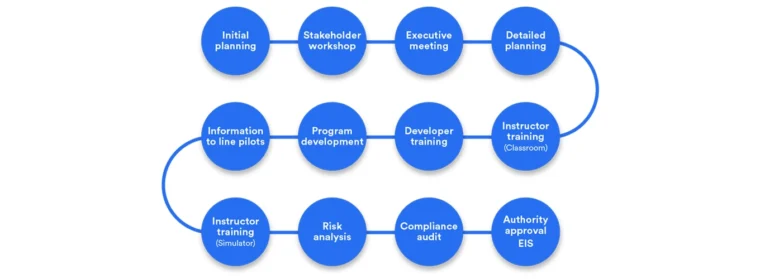Written by Michael Varney and Jeremy Goodman
in collaboration with: Larry McDonald, Michael Langer, John Tobin, John Frearson, John Bent, Nick Papadopoli, Gary Pearson, Henry Emery, Gary Pallett, Stefan Sobol, Kyle Johnston, Barry Gaines, and Mark Dransfield.
This paper advocates for the widespread implementation of a simulation technology (SATCE) in pilot training, including an outline of operational threats, current flight simulation shortcomings, a brief description of the technology, key drivers, and an exploration of the benefits. We answer ‘why’ SATCE is needed and call for it to become a required part of ground-based pilot training, offering a pathway for its adoption at scale.
14 July 2023
Executive Summary
Recent runway incidents in the United States and globally highlight the significant risks posed to flights by communication issues and errors by controllers and other traffic, yet these operational threats remain poorly represented in pilot training using current flight simulator technology.
Continued growth of aviation worldwide will drive the need for pilots that can operate within increasingly busy and complex air traffic systems, while the average experience level of the pilot workforce is declining. Maintaining flight safety is only possible if incoming pilots receive effective and relevant training, and the proficiencies of existing pilots are maintained.
Simulated Air Traffic Control Environment (SATCE) is an immersive training technology that simulates air traffic control and other traffic. Having already been defined by industry, SATCE is currently in use by early adopters and yielding positive results. The technology benefits pilots and flight crews, providing its highest value during real-time scenario-based training, and is applicable across all aviation sectors; commercial, military, fixed-wing, rotary-wing, and emerging markets.
Current practice, which includes ATC role-play by the instructor with little or no moving traffic due to simulator limitations, does not deliver the operational complexity needed to realize the full potential of scenario-based flight training. With SATCE providing the missing simulation of a busy operational environment, pilots in training can build the competencies necessary to identify and manage known threats, especially in high risk flight stages exposed by recent incidents on or near runways.
AI-based training technologies, including SATCE, offer powerful new tools that enhance flight training and provide comprehensive training data. Continued investment growth in AI, alongside further development, offers an exciting potential for SATCE to deliver increasingly effective training through more complex scenarios, heightened realism and immersion.
The paradigm shift in flight training from a largely outcome-based testing approach towards an evidence- and competency-based training philosophy is arguably the single largest industry driver that necessitates SATCE. SATCE has a crucial role to play in the ongoing development and continued evolution of modern flight training, including Evidence-based Training (EBT) and the Advanced Qualification Program (AQP).
In the emerging Advanced Air Mobility (AAM) sector, SATCE will be valuable, not only for pilot training, but also to support vehicle manufacturers and operators obtaining the necessary regulatory approvals before introducing commercial services.
This paper proposes a proactive initiative, involving both industry and regulatory agencies, to facilitate the widespread incorporation of SATCE into flight training, including its regulatory requirement in flight crew licensing and training programs. The FAA’s recent initiation of a collaborative research program evaluating SATCE is an encouraging step forward on the path toward this goal.




